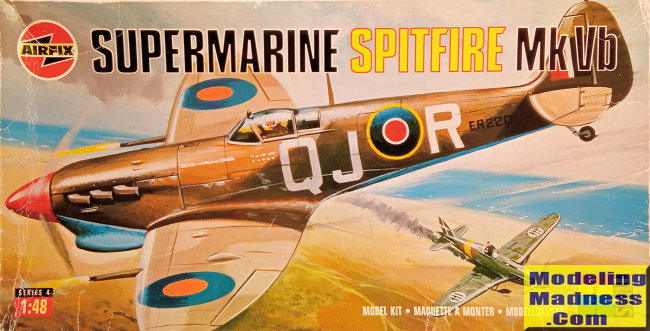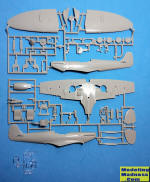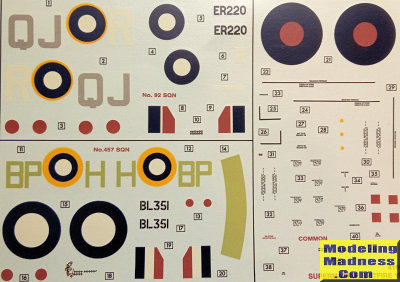
| KIT #: | 04100 |
| PRICE: | $ |
| DECALS: | Two options |
| REVIEWER: | Spiros Pendedekas |
| NOTES: |

| HISTORY |
The Spitfire Mk V is a classic case of a “stop-gap” that performed its required tasks in a most effective manner. Indeed, the plane, which was basically an MkI airframe with a Merlin 45 engine, soldiered on exceedingly well, providing breathing space to the Air Staff that were by that time not too happy with the problems and delays associated with the upcoming Merlin XX. The type served on all battlefronts and was additionally used by nine other countries.
| THE KIT |
 This
is the elderly late 70’s Airfix kit (the fuselage innard has “1979” molded in)
that has been reboxed numerous times ever since, even catering (with the
addition of extra parts) for the Seafire or the IXc/XVIe editions.
Interestingly, a “Hi-tech” edition of the kit came out in the early 90’s
featuring a PE fret and some cast metal parts.
This
is the elderly late 70’s Airfix kit (the fuselage innard has “1979” molded in)
that has been reboxed numerous times ever since, even catering (with the
addition of extra parts) for the Seafire or the IXc/XVIe editions.
Interestingly, a “Hi-tech” edition of the kit came out in the early 90’s
featuring a PE fret and some cast metal parts.
The specific issue is the 1994 edition coming in a medium sized side opening
box, featuring a nevertheless attractive but artistically licensed box art of
Sqd Ldr Neville Duke’s “QJ-R” bird, having downed an Italian
fighter at the Desert Front.
Upon opening the box, I was greeted with 43 light gray styrene parts, arranged
in two equally sized sprues. Molding is old school, with some amounts of flash
being evident. General shapes look correct (in fact, this kit has received
positive comments for its external shape accuracy). Panel lines are mostly
raised, with the engraved ones found around the cowling area and moving surfaces
hinge lines.
Cockpit is average for today’s high standards, but nevertheless includes an
instrument panel with molded-on instruments, a floor with molded-on pedals,
seat, stick, rear bulkhead and gunsight, all reasonably looking. If you go for a
“closed” canopy and use the pilot figure provided, the cockpit will be passable.
Landing gear and wheels are also passable (wheels-up option is also provided)
and the bays are boxed with some internal detail. Radiator, oil cooler and air
inlets (two provided, a “normal’ and a “tropicalized”) are also well done, but
the radiator faces (molded to the wing undersides) are totally flat and they
would benefit from some source of “mesh” looks. The prop is provided with
separate blades, which are reported to have shape issues. The exhausts look also
passable.
Clear parts are well molded and clear, with two styles of windscreens provided,
the canopy is molded in closed position, something not necessarily bad, as a lot
of the cockpit’s sparseness will be hidden under it. Instructions come to the
usual comprehensive older Airfix/Heller style, provided as an A4 b/w booklet
containing a short history of the type, whereas the construction is well spread
in 16 simple and concise steps with full color callouts where needed.
 Two famous
Squadron Leaders’ schemes are provided, for Neville Duke's ER220 tropical and
Johnny Gibson’s BL351 bird. Decals are very well printed, well registered, with
correct color shades and still look usable. I recall some older Airfix/heller
decal sheets being off registered, but it is not the case here: the decal sheet
is perfect.
Two famous
Squadron Leaders’ schemes are provided, for Neville Duke's ER220 tropical and
Johnny Gibson’s BL351 bird. Decals are very well printed, well registered, with
correct color shades and still look usable. I recall some older Airfix/heller
decal sheets being off registered, but it is not the case here: the decal sheet
is perfect.
A note about Neville Duke’s bird: the decals supplied for ER 220 “QJ-R” depict
the “QJ” as light gray and only the “R” in white. Pictorial evidence also shows
“QJ” to be of a light gray shade and quite a few profiles indicate so. Also,
instructions dictate landing gear legs, wheel rims and bay innards to be painted
aluminum and not underside Azure Blue, as was the common practice, at least from
a point onward. Yours Truly being not a Spitfire afficionado, all I can suppose
is that ER220’s provided scheme might be correct for an early painted-over bird
with “tropical” colors.
Instructions want you to first assemble the cockpit and prop, then trap them between the fuselage halves. The wings are then assembled and attached, followed by the tail planes, exhausts, transparencies, antenna mast and wing guns. The landing gear is next assembled and installed, where you can select either extended or retracted. Last step deals with radiator, oil cooler and air inlet (you may select "normal" or "tropical"), ending a simple and seemingly easy build, the only possible concern being parts fit. Of course, you may alter the construction sequence to your preference (for example attaching the clear parts last).
| CONCLUSIONS |
Superseded by many newer offerings, let alone the newer Airfix itself, this
elderly fellow does not by any means pretend to be a Wunderkit. It is a Blast
from the Past, relatively simplistic, soft on the details, not as crisply molded
and the discussion can go on. However, its external shape is correct, its
construction uncomplicated (some filling and sanding will be necessary, though)
and its decals look good. With some extra effort from your standard shake and
bake kit, a nice quarter scale Spitfire can emerge. If you come across one,
resist the temptation to keep it as a collector’s item and give it a try.
Happy modeling!
January 2023
Copyright ModelingMadness.com. All rights reserved. No reproduction in part or in whole without express permission from the editor.
If you would like your product reviewed fairly and fairly quickly, please contact the editor or see other details in the Note to Contributors.